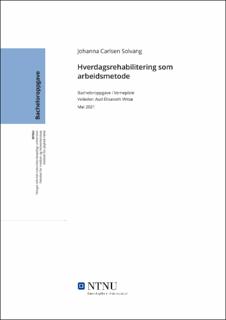| dc.contributor.advisor | Witsø, Aud Elisabeth | |
| dc.contributor.author | Solvang, Johanna Carlsen | |
| dc.date.accessioned | 2021-09-25T16:45:43Z | |
| dc.date.available | 2021-09-25T16:45:43Z | |
| dc.date.issued | 2021 | |
| dc.identifier | no.ntnu:inspera:81471222:38047805 | |
| dc.identifier.uri | https://hdl.handle.net/11250/2783473 | |
| dc.description.abstract | Tittel: Hverdagsrehabilitering som arbeidsmetode
Bakgrunn: Helsetjenesten har i lang tid vært preget av ressursutfordringer som påvirker verdiene i yrkesutøvelsen. De siste årene har rehabilitering av eldre i hjemmet fått mer oppmerksomhet grunnet økt antall eldre i samfunnet, og behovet for å styrke tjenestene gjennom tilpasning etter brukerens preferanser.
Hensikt: Hensikten med oppgaven er å gi et kunnskapsbidrag til hva helsepersonell vektlegger i sitt arbeid med hverdagsrehabilitering, samt hvilken rolle vernepleieren kan inntre.
Metode: Kunnskapsgrunnlaget er bygget opp på metoden litteraturstudie med kvalitativ forskningsmetode. Jeg tar for meg fem forskningsartikler, samt annen relevant teori.
Resultat: Med utgangspunkt i de fem forskningsartiklene ble tre hovedfunn identifisert. Resultatene fra artiklene blir diskutert nærmere i oppgaven: kjennetegn med tverrprofesjonelt samarbeid, «hva er viktig for deg?» og utfordringer med rehabiliterende tilnærming i hjemmet.
Konklusjon: Innovasjon av helse- og omsorgstjenesten er avgjørende for å øke selvstendigheten til eldre i fremtiden. Behovet for å ivareta brukeren og tjenesteyterne er verdifullt for å kunne utgi omsorgsfull og forsvarlig hjelp. Helsepersonell opplever hverdagsrehabilitering som en arbeidsmetode som skaper entusiasme og økt fagkunnskap. I praksis utfordres arbeidsformen grunnet tjenesteapparatets ressursmangler og verdigrunnlag, som kan skape motspill på individ- og systemnivå. Godt tverrfaglig samarbeid og brukermedvirkning påvirker hvor vellykket rehabiliteringsprosessen blir.
Nøkkelord: Eldre, hverdagsrehabilitering, helsepersonell, innovasjon
Antall ord: 6800 | |
| dc.description.abstract | Title: Home-based rehabilitation as working method
Background: The health service has for a long time been characterized by resource challenges that affect the values in the practice of the profession. In recent years, the rehabilitation of the elderly in the home has received more attention due to the increased number of the elderly in society, and the need to strengthen the services through adaptation to the user's preferences.
Purpose: The purpose of the assignment is to provide a knowledge contribution to what health personnel emphasize in their work with home-based rehabilitation, as well as what role the learning disability nurse can play in situations.
Method: The knowledge base is built on the method literature study with qualitative research method. I’m using five research articles, as well as other relevant theory.
Result: Based on the five research articles, three main findings were identified. The results from the articles are discussed in more detail in the assignment, which are: characteristics of interprofessional collaboration, "what is important to you?" and challenges with the rehabilitative approach in the home.
Conclusion: Innovation of the health and care service is crucial to increase the independence of the elderly in the future. The need to take care of the user and the service provider is dependent on being able to provide caring and justifiable help. Healthcare professionals experience home-based rehabilitation as a working method that creates enthusiasm and increased professional knowledge. The service apparatus' lack of resources and values make the working method challenging for service providers in practice, which can create counterplay at the individual and system level. Good interprofessional collaboration and user participation affect how successful the rehabilitation process will be.
Keywords: Older-people, home-based rehabilitation, Teams` experiance, innovation
Number of words: 6800 | |
| dc.language | nob | |
| dc.publisher | NTNU | |
| dc.title | Hverdagsrehabilitering som arbeidsmetode | |
| dc.type | Bachelor thesis | |
